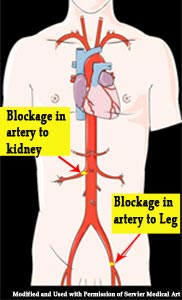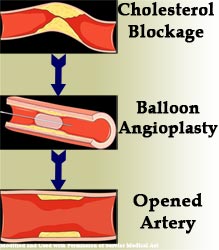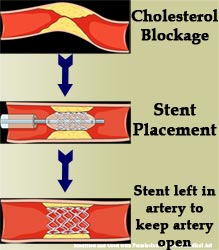In This Section
- Clinics
- Anticoagulation (Coumadin)
- Defibrillators
- Hypertension
- Pacemakers
- Tests & Treatments
- Ambulatory Rhythm Monitoring
- Angioplasty and Stents
- Ankle-Brachial Index (ABI)
- Biventricular Pacemaker
- Blood Pressure Monitoring
- Cardiac Catheterization
- Cardiac Computed Tomography
(CT) - Carotid Ultrasound
- Echocardiography
- Electrophysiology
- Exercise Stress Testing
- Pacemakers & Defibrillators
- Peripheral Vascular Disease
Peripheral Vascular Disease Treatment
 Many of the risk factors for coronary artery disease (diabetes, smoking and high cholesterol) can also lead to blockages in other arteries which feed the kidneys or legs. This is known as peripheral vascular or peripheral artery disease (PAD). Blockages in the arteries to the kidneys can lead to uncontrolled hypertension and kidney failure while blockages in the arteries to the legs can lead to cramping in the legs or buttocks when patients walk. These leg symptoms are known as "claudication." Our interventional cardiologists are experts in manipulating catheters in the heart and these same skills can also be used to use balloons and stents to open these other blockages without the need for major surgery in the appropriate patient. Your physician can help you decide if these procedures are appropriate for your condition.
Many of the risk factors for coronary artery disease (diabetes, smoking and high cholesterol) can also lead to blockages in other arteries which feed the kidneys or legs. This is known as peripheral vascular or peripheral artery disease (PAD). Blockages in the arteries to the kidneys can lead to uncontrolled hypertension and kidney failure while blockages in the arteries to the legs can lead to cramping in the legs or buttocks when patients walk. These leg symptoms are known as "claudication." Our interventional cardiologists are experts in manipulating catheters in the heart and these same skills can also be used to use balloons and stents to open these other blockages without the need for major surgery in the appropriate patient. Your physician can help you decide if these procedures are appropriate for your condition.
An angioplasty is performed by a similar procedure to a diagnostic cardiac catheterization but may take 1 to 2 hours. The same small hollow tubes are used and dye is injected into the artery of the leg or kidney. Once a blockage is identified, a small narrow wire, the width of a hair, is inserted past the blockage and a deflated cigar-shaped balloon is guided over the wire. The balloon is then placed in the location of the blockage and is inflated under high pressure to push the cholesterol plaque into the walls of the artery allowing blood to again flow freely through the artery. Depending on the blockage, multiple inflations may be necessary to restore blood flow. After the procedure, the wire and balloon are both removed from the body.
 If the anatomy of the artery is appropriate, a stent is often used to buttress the artery after the narrowed portion of the artery is opened.
If the anatomy of the artery is appropriate, a stent is often used to buttress the artery after the narrowed portion of the artery is opened.
Similar to an angioplasty, a balloon is placed over the site of the blockage, but in this case, a stent covers the balloon and is expands into the wall of the artery when the balloon is inflated. The wire and balloon are then both removed as in an angioplasty, but the stent is left behind. In the right patient, it is often more effective than angioplasty in helping to keep the artery open. It eventually becomes embedded in the artery and cannot be removed after it is placed. The stent is made of metal but certain conditions may benefit from a drug impregnated onto the stent to prevent the blockage from growing back. These drug-coated stents are not for every patient, and your cardiologist can help decide which is best for you. In either situation, the patient will need to take both aspirin and clopidogrel (Plavix®) to prevent the stent from clotting.
 With both balloon angioplasty and stent procedures, a plug is often placed in the artery to stop the bleeding or otherwise the site is compressed for about 10 or 15 minutes until the artery clots. There is a mandatory bed rest period after the procedure lasting from 2 – 6 hours.
With both balloon angioplasty and stent procedures, a plug is often placed in the artery to stop the bleeding or otherwise the site is compressed for about 10 or 15 minutes until the artery clots. There is a mandatory bed rest period after the procedure lasting from 2 – 6 hours.
What to Expect Before the Procedure:
- If you have had a reaction to contrast, shellfish or iodine in the past, please let your cardiologist know immediately.
- Nothing to eat after the midnight before the procedure.
- You may take your pills with small sips of water.
- Diabetes pills should be held and if you take insulin, ask your physician how the dose should be adjusted.
- Glucophage (Metformin®) should be withheld the day before and a few days after the procedure.
- We prefer patients to continue aspirin and plavix if previously prescribed. If you take Coumadin, please ask your cardiologist if these should be withheld before the procedure.
- You may bring a CD of your favorite music to help you relax
What to Expect After the Procedure:
- There may be soreness at the incision site and possibly some swelling and bruising.
- There may be a small, walnut-sized lump at the access site which should become smaller and becomes less tender within days
- 1b. There may be a small area of bruising following the procedure which may seem to get larger and expand down the leg. This is often seen and does not typically represent ongoing bleeding but often represents old blood under the skin which is traveling in the direction of gravity
- Avoid any significant physical activity or heavy lifting for the first few days after the procedure
- The patient may resume driving the day following the procedure
- Avoid taking a bath for a few days; showers may be taken within 24 hrs
When to Call your Physician or 9-1-1:
- Bleeding at the access site. Pressure should be applied to the site by a friend/family member until medical advice is obtained.
- Severe tenderness, discharge or fever.
Complications:
Complications of the procedure are rare but could include a blood vessel tear or bleeding, reaction/allergy to medication or contrast, kidney complications or very rarely stroke or heart attack.